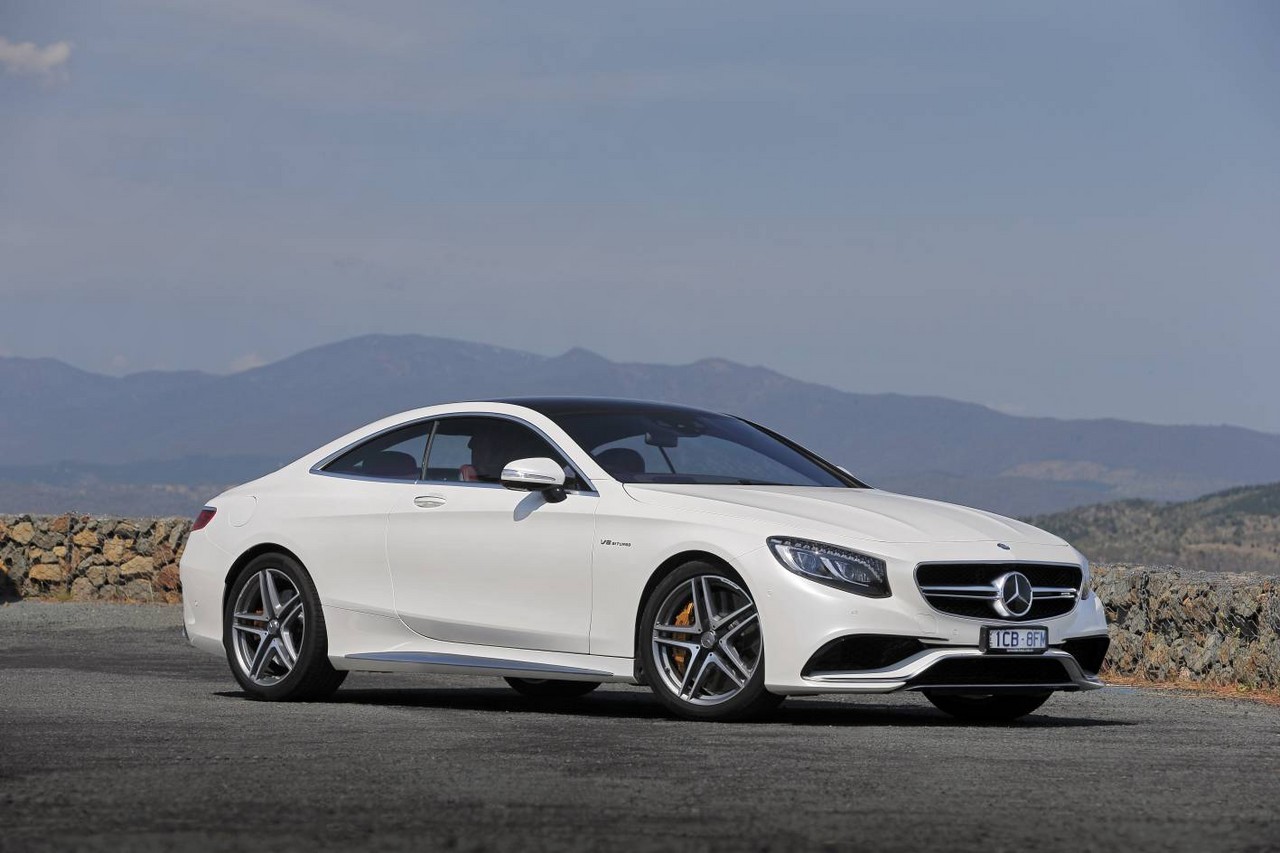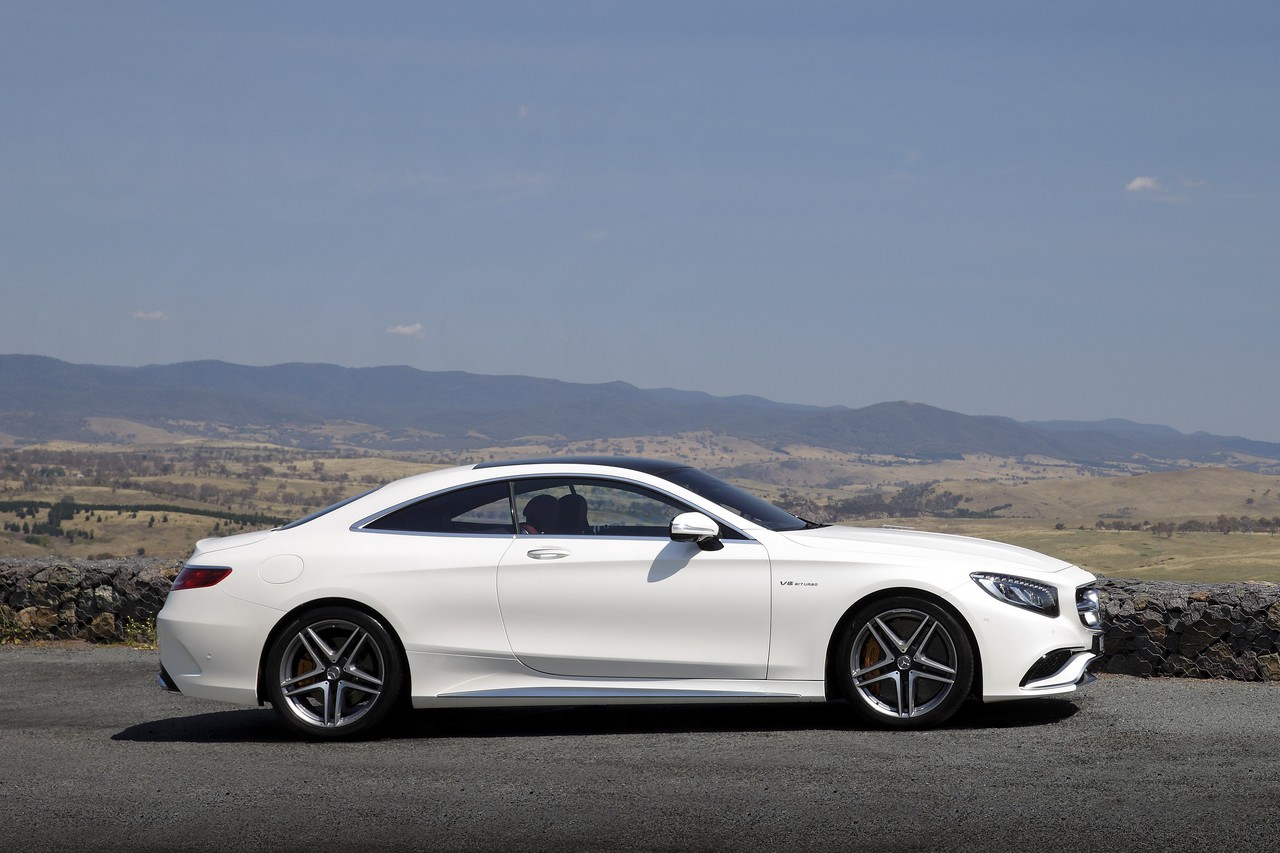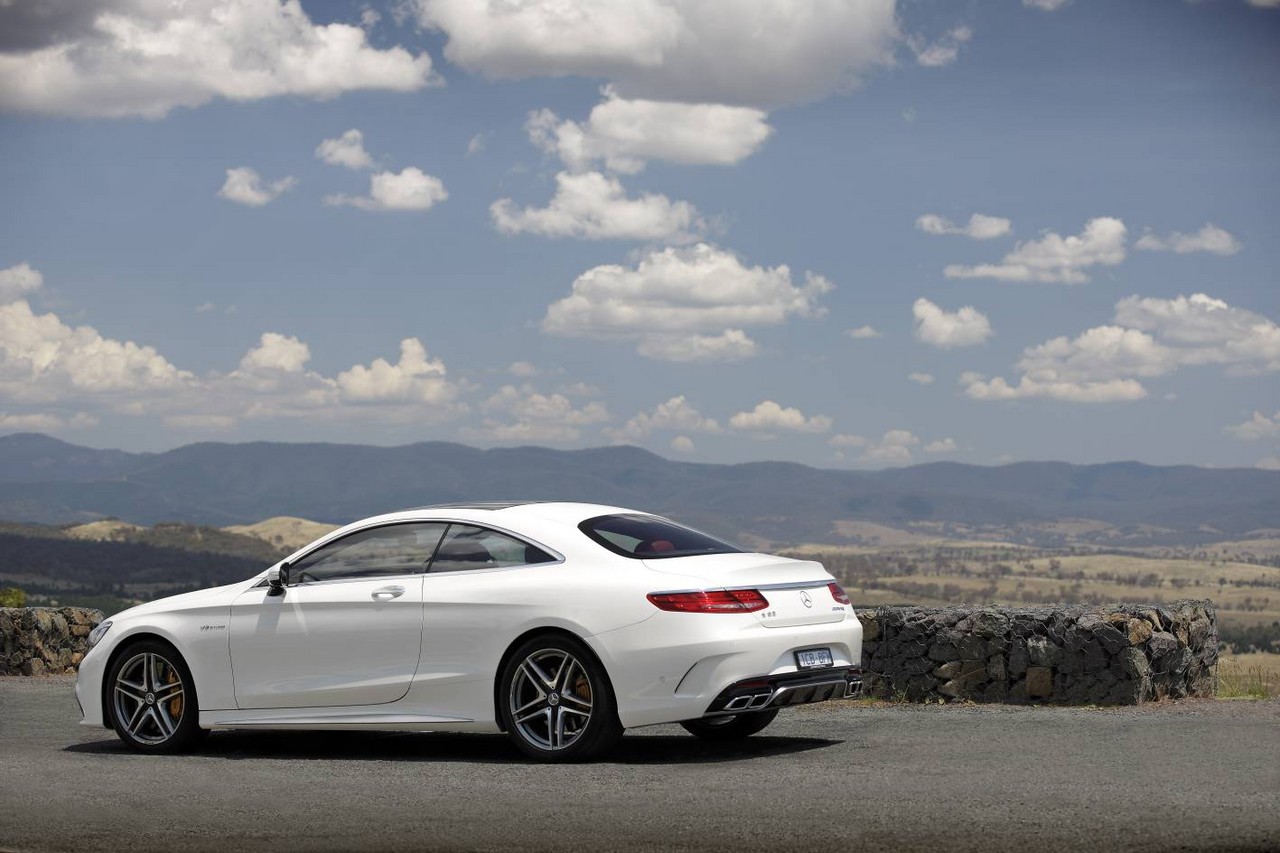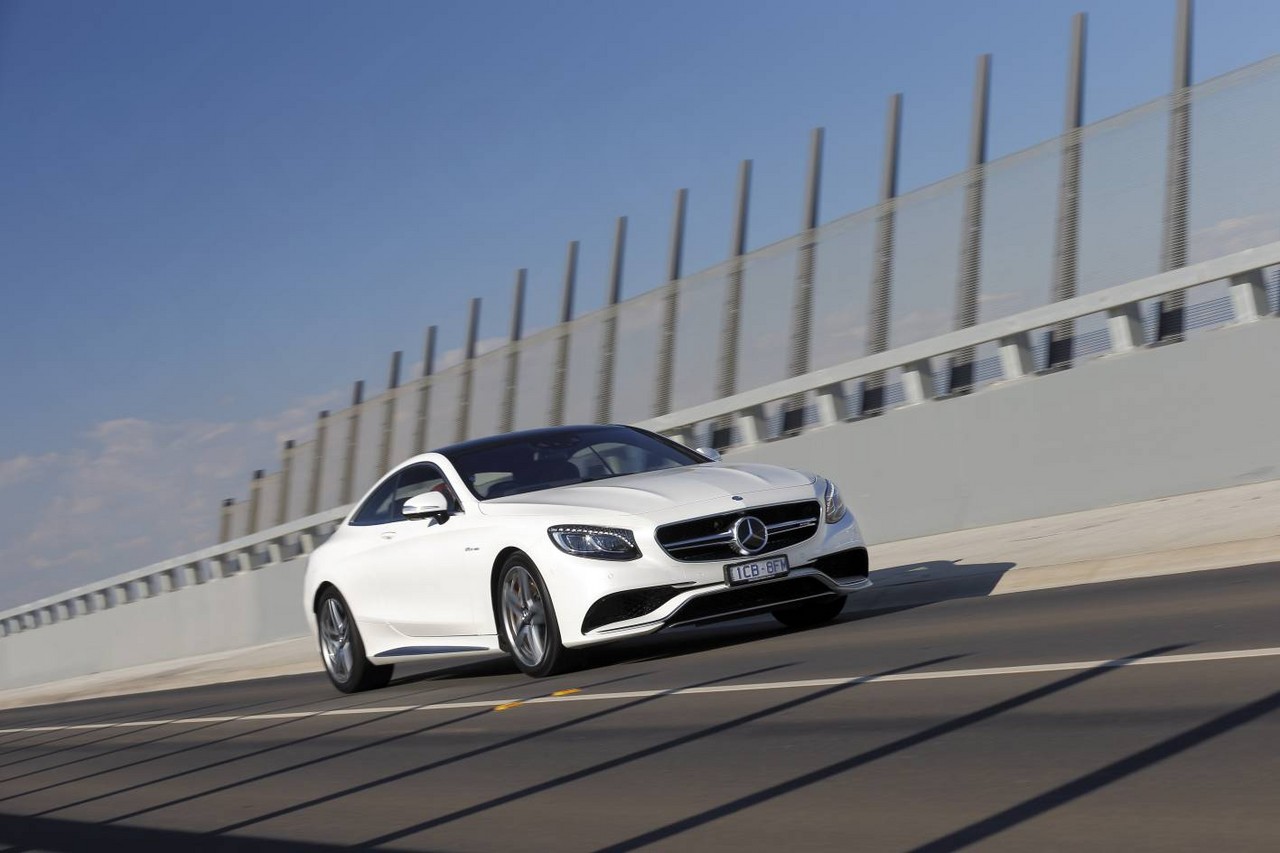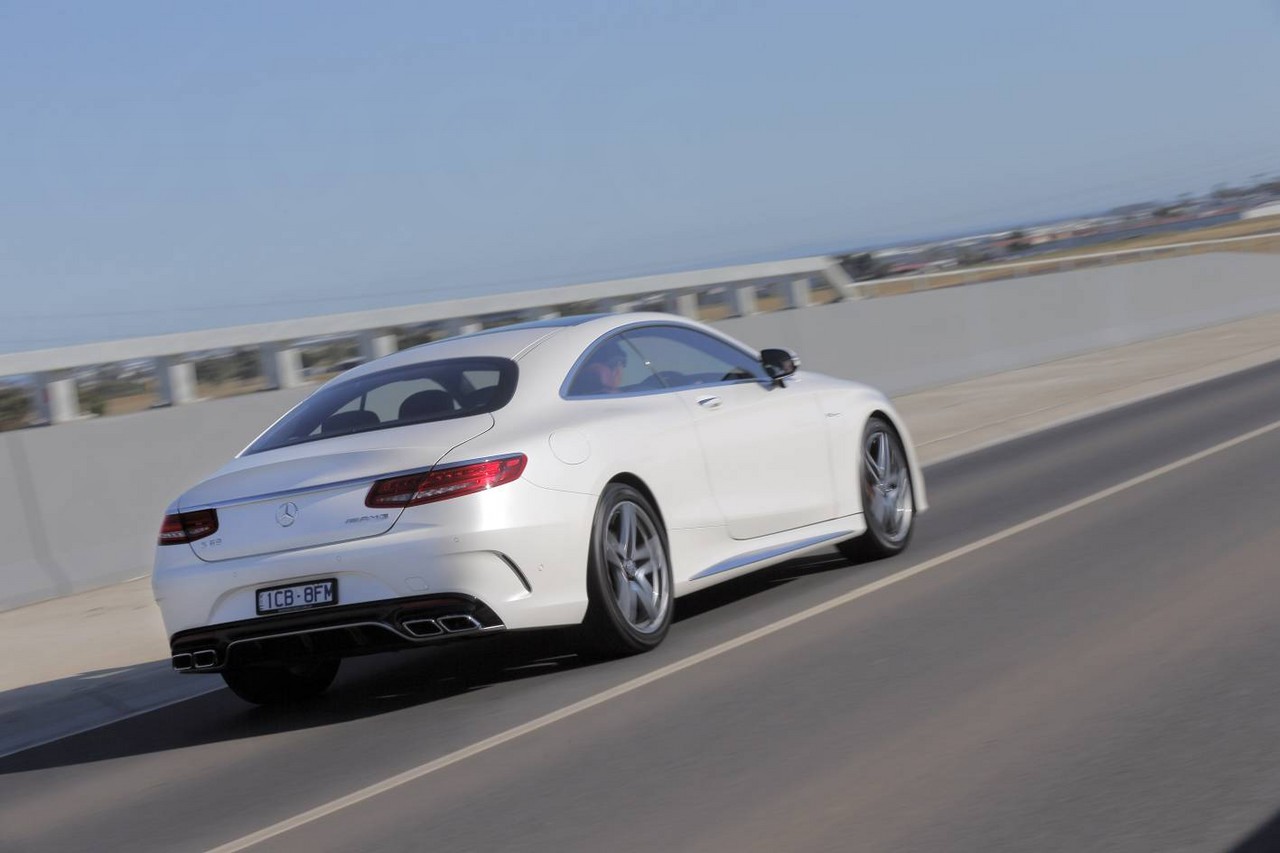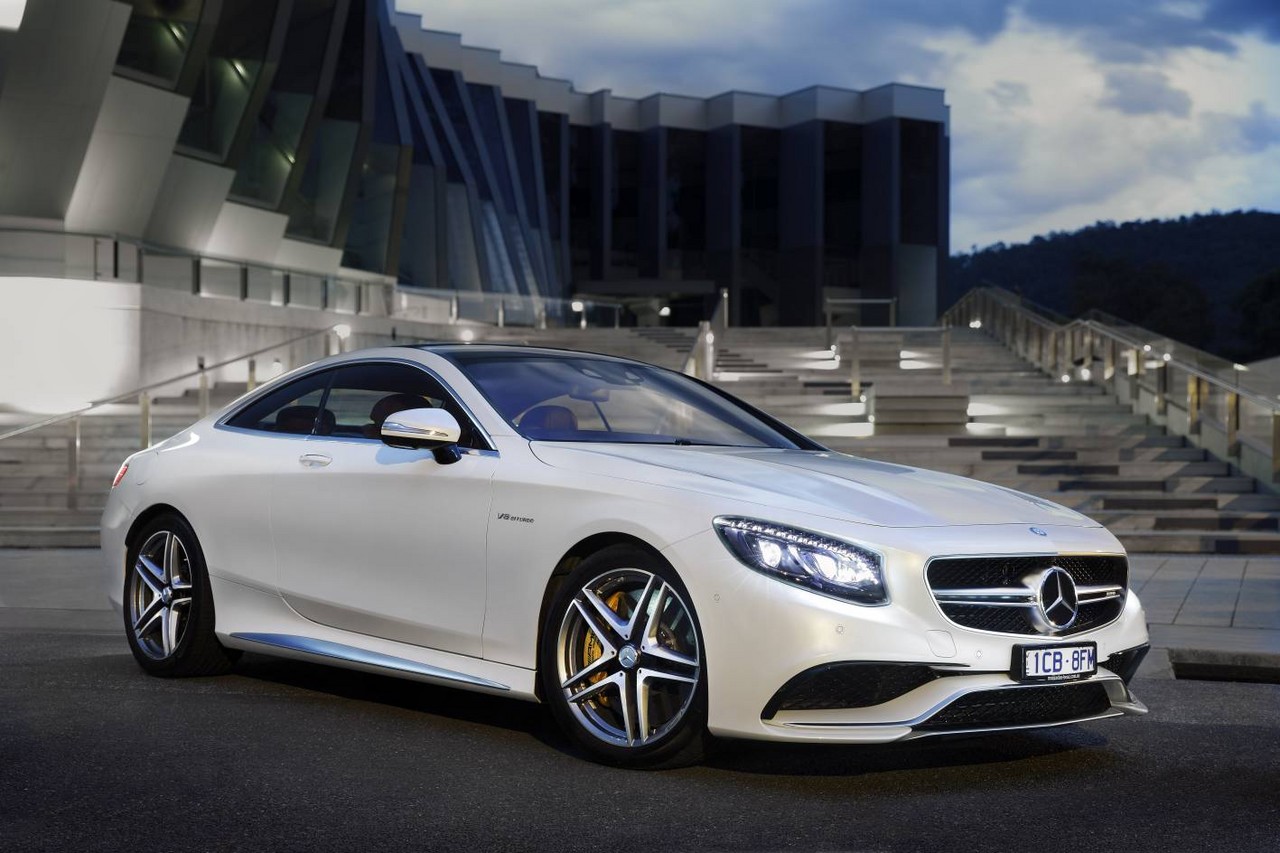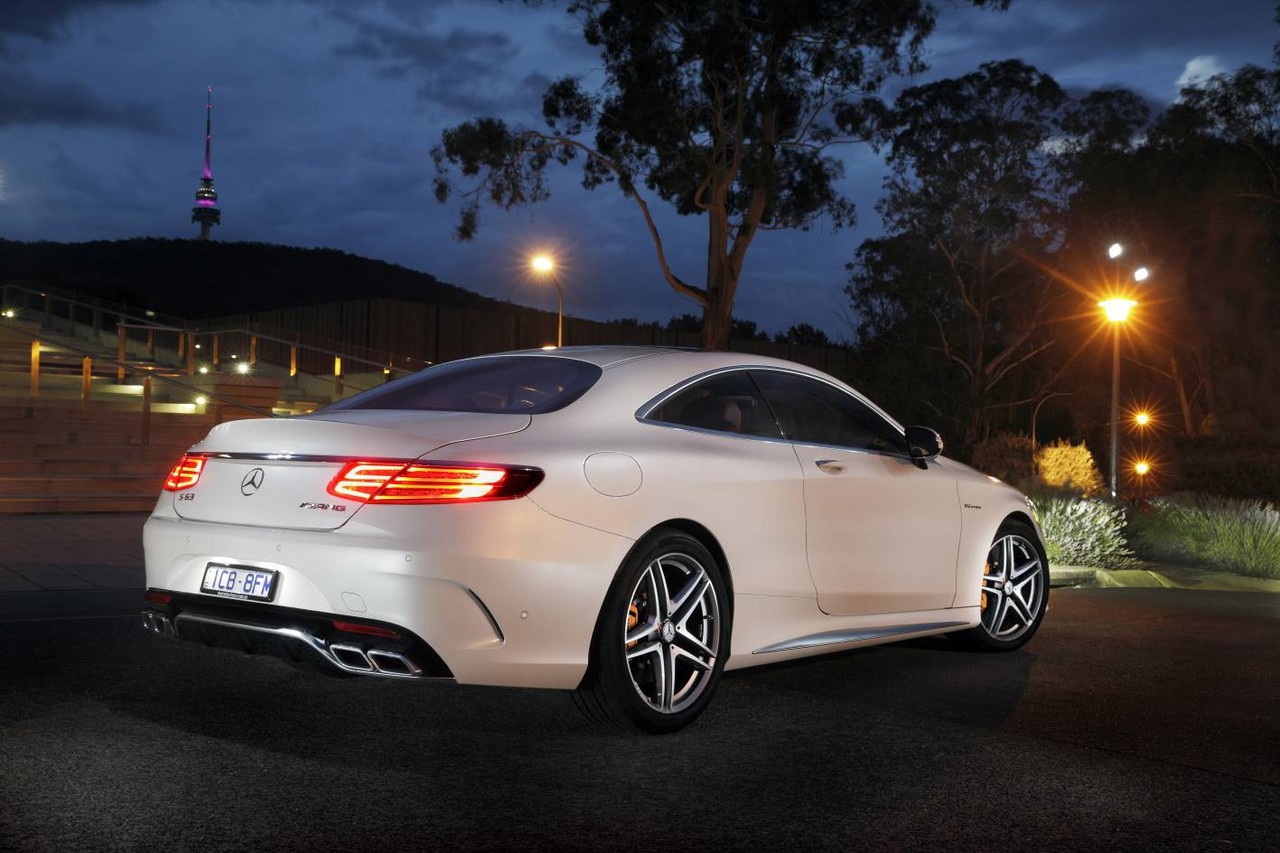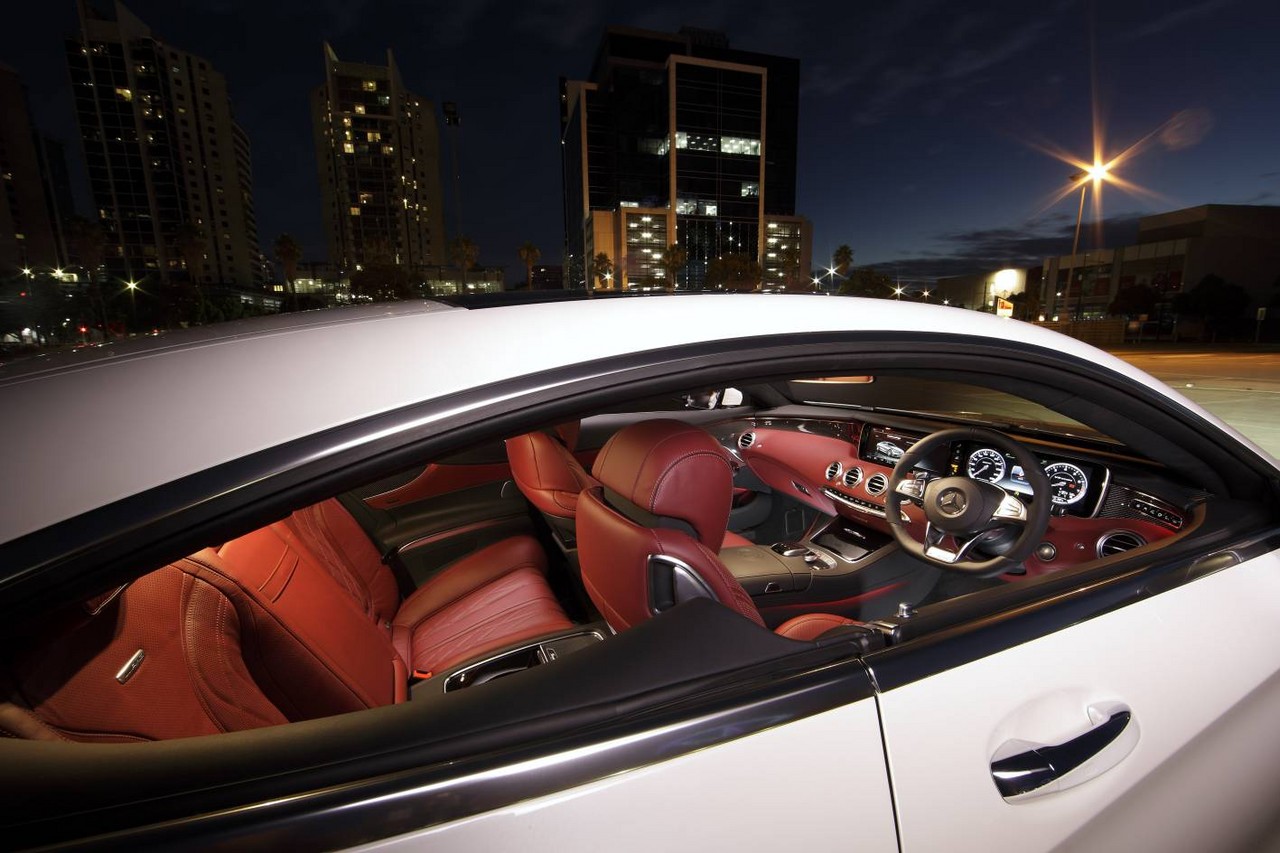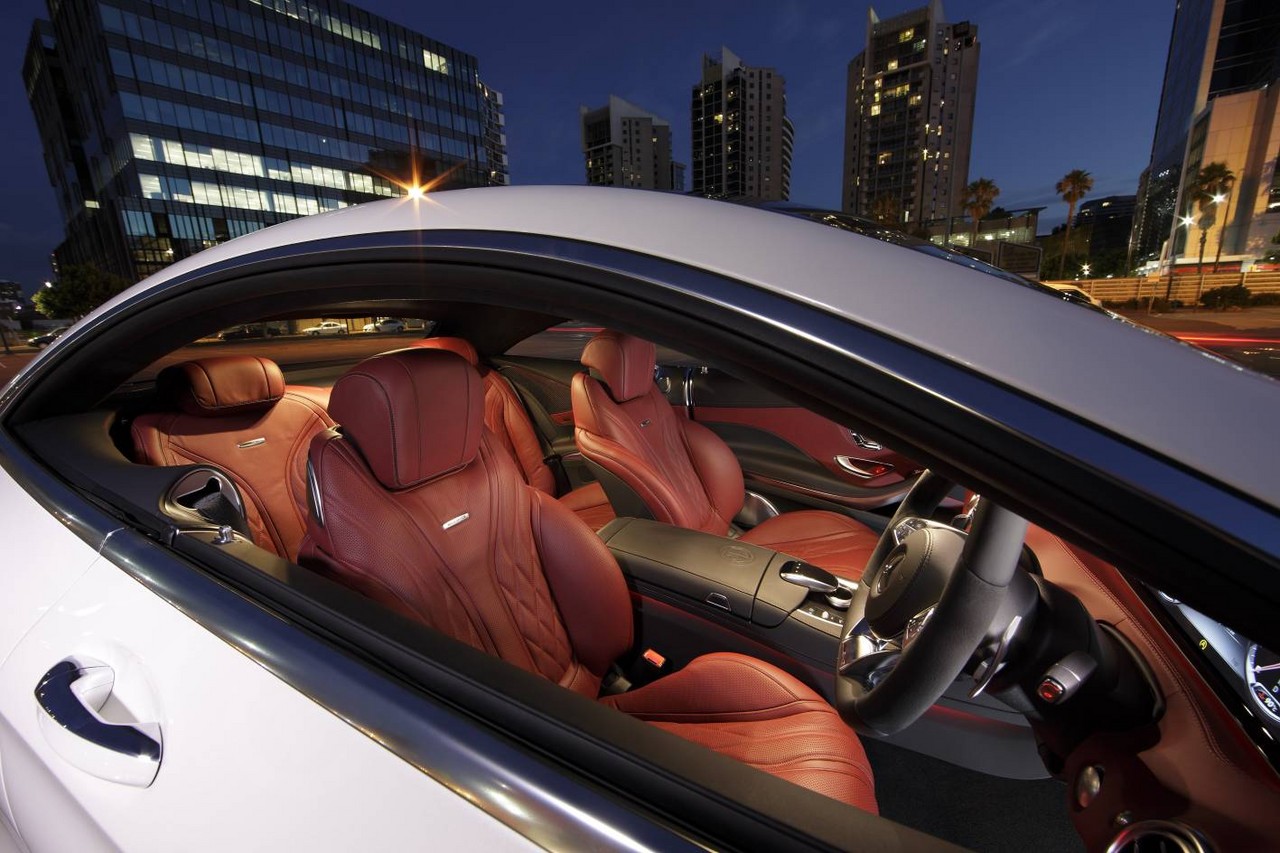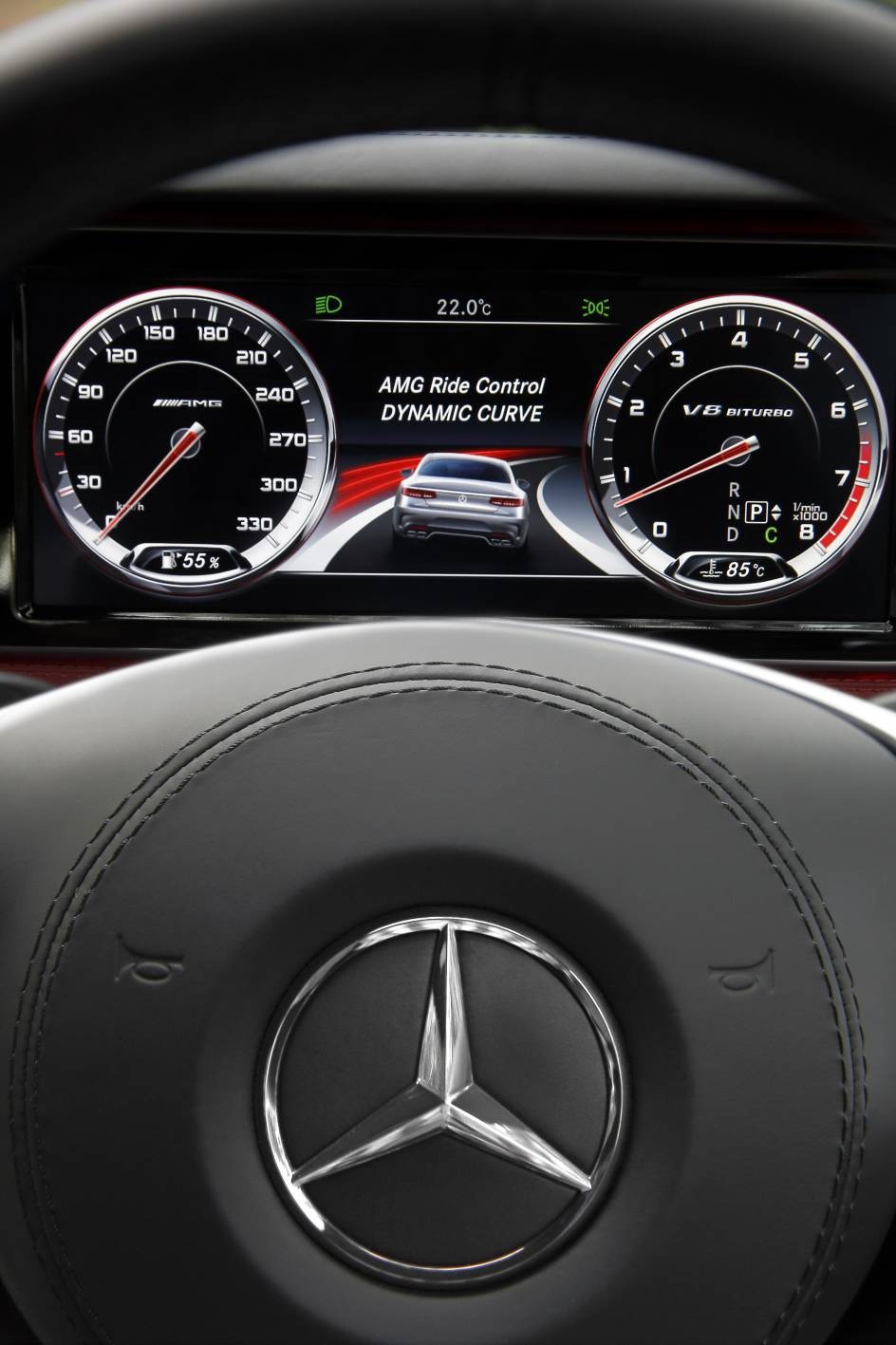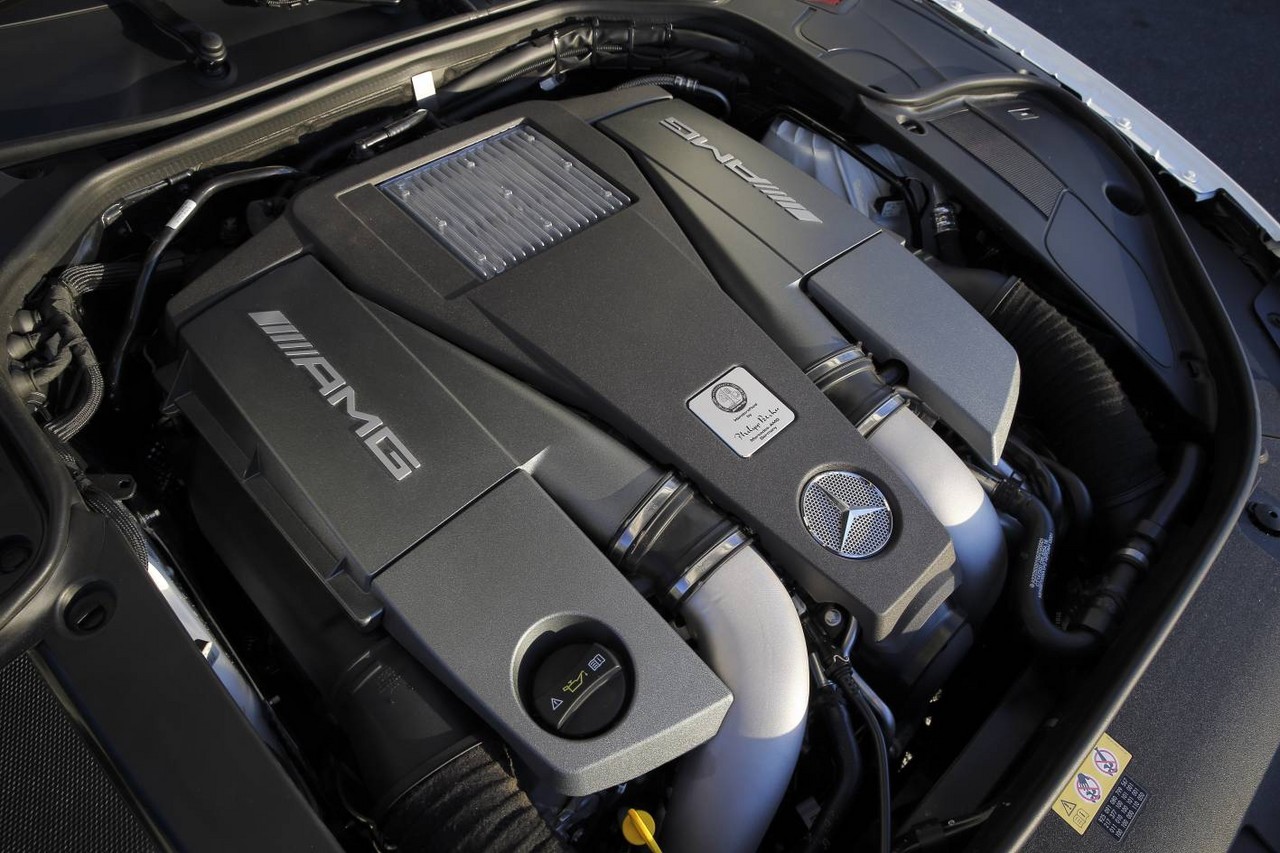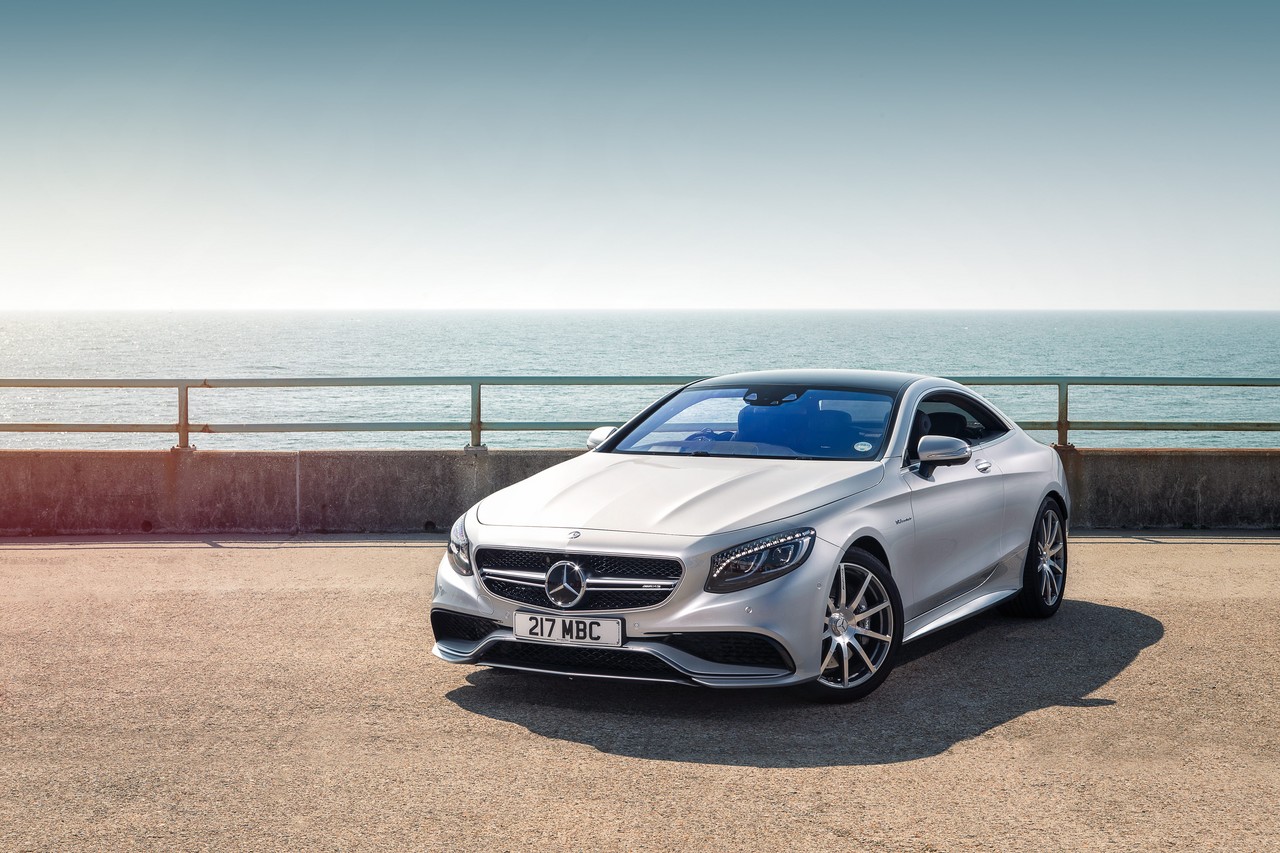
- AMG Speedshift MCT can provide jerky gearshifts at low speeds
- Styling compromises rear seat space
- Small boot
- High running, maintenance and depreciation costs
Mercedes C217 S 63 AMG and S 65 AMG Coupe (2015-20)
Overview
Released in Australia in February 2015, the Mercedes-Benz C217 S-Class Coupe was a pillarless, four-seat coupe. Manufactured in Sindelfingen, Germany, the rear-wheel drive AMG S-Class Coupe range initially consisted of the S 63 AMG, with the S 65 AMG following in June 2015.
S 63 AMG: biturbo M157 V8 engine
The M157 V8 engine had an aluminium block with cast-in aluminium-silicon (Silitec) cylinder liners, forged crankshaft made of 38MnS6BY steel alloy (a combination of manganese, sulphur, boron and yttrium) with eight counterweights and rotating in five main bearings, fracture-split forged connecting rods, an aluminium cylinder head, double overhead camshafts (driven by three high-performance chains), variable intake and exhaust camshaft adjustment over a range of 40 degrees via four pivoting actuators, four valves per cylinder and a compression ratio of 10.0:1. Furthermore, the M 157 had a dry weight of 204 kg, maximum engine speed of 6400 rpm and Bosch MED 17.7.3 control unit.
Significantly, the M157 engine had spray-guided direct injection with piezo fuel injectors (operating at 100 to 200 bar on a demand-related basis), a Garrett MGT2260MSL turbocharger for each cylinder bank (welded to the exhaust manifold) and air/water intercooling. To minimise fuel consumption, the M157 engine had an ‘ECO start/stop system’ – which the driver could disable if desired – and multi-spark ignition whereby the spark plugs could fire multiple times during the combustion sequence for more efficient combustion.
The S 63 AMG Coupe could accelerate from rest to 100 km/h in 4.3 seconds and had an electronically-limited top speed of 250 km/h. Over the combined ADR 81/02 cycle, fuel consumption for the S 63 AMG Coupe was 10.2 litres per 100 km.
S 65 AMG: biturbo M279 V12 engine
The 5980 cc M279 V12 engine had an aluminium alloy block with 82.6 mm bores and a 93.0 mm stroke, an aluminium alloy cylinder head, manifold fuel injection, a single overhead camshaft per cylinder bank, a one-piece chain drive, a forged crankshaft, forged pistons, twin turbochargers, an air-to-liquid intercooler, three valves per cylinder (two intake and one exhaust, the latter filled with sodium) that were actuated by aluminium roller rocker arms and twelve double ignition coils (for multi-spark ignition). Furthermore, the M279 engine had a compression ratio of 9.0:1.
To minimise fuel consumption, the M279 V12 engine had an ECO start/stop system which could shut down the engine when the vehicle was stationary in traffic. Over the combined ADR 81/02 cycle, fuel consumption for the S 65 AMG Coupe was 12.0 litres per 100 km. Furthermore, the S 65 AMG Coupe could accelerate from rest to 100 km/h in 4.1 seconds and had an electronically-limited top speed of 250 km/h.
| Engine | Trans. | Peak power | Peak torque | |
|---|---|---|---|---|
| S 63 AMG | 5.5-litre twin-turbo petrol V8 (M157 DE55 AL) | 7sp semi-auto | 436 kW at 5500 rpm | 900 Nm at 2250-3750 rpm |
| S 65 AMG | 6.0-litre twin-turbo petrol V12 (M279 E 60 AL) | 7sp auto | 463 kW at 4800-5400 rpm | 1000 Nm at 2300-4300 rpm |
AMG Speedshift transmissions
For the S 63 AMG, the seven-speed ‘AMG Speedshift MCT’ (Multi Clutch Technology) had a compact, wet start-up clutch that operated in an oil bath rather than a conventional torque converter. For the S 65 AMG, however, the ‘AMG Speedshift Plus 7G-Tronic’ transmission had a conventional torque converter.
For both transmissions, the driver could use steering wheel mounted paddles to change gears and select from three driver modes:
- Controlled Efficiency: enabled the ECO start/stop function, provided softer throttle response, smooth gearshifts and maximum power steering assistance;
- Sport: for greater throttle response, faster gearshifts and less steering assistance; and,
- Manual: for maximum throttle response, faster gearshifts and gearshifts via the gearshift paddles.
Dimensions
Sharing its platform with the W222 S-Class , the S-Class Coupe had an aluminium hybrid bodyshell. Compared to the C216 CL AMG , the C217 S-Class Coupe was 38 mm shorter (at 5027 mm), 28 mm wider (1899 mm), 7 mm lower (1411 mm) and had a 10 mm shorter wheelbase (2945 mm); boot capacity was 400 litres. The S 63 AMG Coupe and S 65 AMG Coupe both had a drag coefficient of 0.30 Cd.
Suspension and Magic Body Control
The C217 S-Class Coupe had four-link front suspension and multi-link independent rear suspension (both with air springs, monotube shock absorbers and anti-roll bars). As standard, the suspension of the S-Class Coupe included Mercedes-Benz’s Magic Body Control which included Active Body Control and Road Surface Scan functions. The Road Surface Scan used a stereo camera to detect road curvature and undulations up to 15 metres ahead. Using this information, Magic Body Control could prepare the air springs and individually adjustable suspension struts (Active Body Control) accordingly.
In a first for a production car, however, the C217 S-Class Coupe also had a curve tilting function which can operate at speeds between 30 km/h and 180 km/h and enables the vehicle to lean into bends by up to 2.5 degrees (depending on the road angle and vehicle speed) by shifting the base point of each individual strut. For Australia, the curve tilting function was also fitted as standard.
Steering
The Mercedes S 63 AMG Coupe and S 65 AMG Coupe had electromechanical, variable ratio steering. The level of power-assistance varied with vehicle speed and the drive mode selected for the transmission; in Comfort mode, for example, additional assistance was provided.
Safety equipment
Standard safety equipment for the Mercedes C217 S-Class AMG included dual front airbags, a driver’s knee airbag, seat-mounted thorax/pelvis airbags for front occupants, thorax/pelvis airbags in the rear interior side panels for rear occupants, full-length curtain airbags, ABS, brake assist, electronic brake force distribution, electronic stability control, traction control, and front and outer rear seatbelts with pre-tensioners and load limiters. The S-Class Coupe was also fitted with an ‘active bonnet’ that would rise in the event of a pedestrian collision to cushion the pedestrian’s subsequent impact with the bonnet.
In addition to the anticipatory ‘Pre-Safe’ safety measures (such as priming of the brakes in emergency situations, tensioning the seatbelts and closing the windows), Mercedes-Benz’s standard ‘Pre-Safe’ technologies for the C217 S-Class AMG included:
- Pre-Safe Brake with pedestrian detection (autonomous emergency braking): using two 24 GHz sensors behind the front bumper which had a range of 30 metres and a 77 GHz radar which had a range of 200 metres, Pre-Safe Brake operated at speeds between 30 km/h and 200 km/h, and at speeds below 70 km/h if the vehicle was approaching a stationary queue of traffic. Around 2.6 seconds before the anticipated moment of impact, an audible warning would sound and a red warning would appear in the tachometer. Around 1.6 before the calculated impact, the first stage of Pre-Safe Brake would initiate partial braking autonomously with around 40 per cent of the maximum braking power (approximately four (4) m/s2); the Pre-Safe occupant protections system would also be activated. If the driver then applied the brakes, maximum braking force would be made available. If the driver failed to react, Pre-Safe Brake would – in its second stage – initiate autonomous emergency braking (i.e. maximum braking power) around 0.6 seconds before the unavoidable collision to reduce the severity of the impact. The pedestrian recognition function enabled Pre-Safe Brake to detect pedestrians when driving at speeds of up to 50 km/h;
- Pre-Safe Plus: could anticipate rear-end collisions and warn following traffic by flashing the rear hazard warning lights at high frequency; and,
- Pre-Safe Impulse: in the event of a collision, both front occupants would initially be pulled away from the direction of impact by their seat belts prior to the subsequent occupant deceleration (reducing the risk and severity of injuries in a frontal collision).
Further safety equipment – fitted as standard – included:
- Distronic Plus (adaptive cruise control with brake warning): an ‘adaptive’ cruise control system which used two short-range radar sensors positioned behind the front bumper to monitor the road up to 30 metres ahead, and a long-range radar located behind the radiator grille which had a range of 200 metres. Operating at speeds up to 200 km/h, Distronic Plus used an electronic control unit to analyse the information from both radar systems to calculate the engine, automatic transmission and braking parameters required for proximity control. As such, Distronic Plus could automatically apply the brakes to prevent the vehicle from becoming too close to traffic ahead (the time interval could be specified) and accelerate back to the set speed when traffic allowed. To accelerate from rest, the driver only needed to operate the Distronic stalk on the steering column or briefly depress the accelerator pedal. With Distronic Plus, automatic deceleration of up to four (4) m/s2was possible. If Distronic Plus detected that heavier braking was required, a warning light would illuminate in the instrument cluster and be accompanied by an audible warning. Furthermore, the electronic proximity control system could be activated independently of Distronic Plus at speeds over 30 km/h to alert the driver if they were approaching another vehicle too rapidly;
- Steering Assist with Stop&Go Pilot: operating in conjunction with Distronic Plus and at speeds up to 130 km/h, Steering Assist used a stereo camera located behind the windscreen to detect road markings, while the Stop&Go Pilot operated at speeds up to 60 km/h and enabled the system to use the vehicle in front or road markings as a means of orientation. If the vehicle was detected to be drifting out of its lane, Steering Assist would warn the driver and provide steering intervention to keep the vehicle in its lane;
- Cross-Traffic Assist: could operate at speeds up to 72 km/h and used the stereo camera and radar sensors to detect traffic that was crossing in front of or behind the vehicle. If detected, the driver would receive visual and audible alerts;
- Active Blind Spot Assist: active at speeds above 60 km/h, a corrective braking force would be applied to the wheels on one side of the vehicle if the driver attempted to change lanes when a vehicle was detected in the driver’s blind spot;
- Active Lane Keeping Assist: would vibrate the steering wheel as the vehicle approached a continuous lane marking line and, if crossed, automatically brake wheels on one side of the vehicle to return the vehicle within the lane;
- Crosswind Assist: could detect sudden, strong gusts of wind and prevent the vehicle from drifting out of its lane via corrective braking forces on one side of the vehicle; and,
- Attention Assist with drowsiness detection: operated at speeds in excess of 80 km/h and assessed driver behaviour (including steering movements) for signs of drowsiness; if detected, the driver would be provided with visual and audible warnings.
The S 65 AMG was also fitted with Night View Assist Plus which used a thermal imaging camera and could alert the driver to the hazards of pedestrians or animals in unlit areas ahead of the vehicle by automatically switching from the speedometer to a night view image which highlighted the sources of danger. A spotlight function could also flash any pedestrians detected ahead.
Brakes: S 63 AMG and S 65 AMG
Both the Mercedes S 63 AMG and S 65 AMG were fitted with an AMG high performance composite braking system which included 390 mm by 36 mm front discs and 360 mm by 26 mm rear discs.
Features: Mercedes S 63 AMG Coupe
Standard features for the Mercedes S 63 AMG Coupe included 20-inch AMG five twin-spoke alloy wheels (8.5J front and 9.5J rear) with 255/40 R20 front and 285/35 R20 rear tyres, a 590 watt Burmester surround sound system with thirteen speakers and a nine-channel amplifier, DAB+ digital radio tuner, CD/DVD player and 10GB media register, COMAND Online with a 31.2 cm display, 3D navigation maps, integrated WLAN hotspot, DVB digital TV tuner, auxiliary inputs (two USB ports/SDHC), ‘Linguatronic’ voice recognition, Bluetooth mobile phone connectivity and audio streaming, dual-zone climate control air conditioning (‘Thermotronic’), active multi-contour AMG sports seats with perforated nappa leather upholstery, power adjustable front seats with ventilation and heating functions, cruise control with speed limiter, LED headlights with adaptive high beams, LED daytime running lights, automatic headlights, rain-sensing wipers, front and rear parking sensors (‘Parktronic’), a 360 degree surround view camera, a three-spoke AMG sports steering wheel with nappa leather and ‘Dinamica’ micro-fibre trim, remote central locking, proximity key (for keyless entry and ‘keyless go’), power windows, power mirrors with heating and folding functions, a power adjustable steering column, memory settings (for the front seats, mirrors and steering wheel positions), panoramic glass sunroof with powered blind, a powered rear blind, soft-close doors, electrochromatic rear view and door mirrors, a 12 volt power socket, ambient lighting, black poplar wood trim, AMG sports pedals, floor mats, AMG instrument cluster, stainless steel illuminated door sills, tyre pressure monitoring, remote boot lid operation, a trip computer, an alarm and immobiliser.
As standard, the S-Class AMG Coupe was also fitted with Active Parking Assist which could identify suitable parallel parking spaces – when traveling at speeds of up to 36 km/h – and autonomously steer the vehicle as the driver reversed towards the parking space.
Features: Mercedes S65 AMG Coupe
The Mercedes S 65 AMG Coupe was distinguished by its 20-inch multi-spoke forged and ceramic polished alloy wheels (8.5J front and 9.5J rear), Burmester ‘High End’ 3D surround system, ‘Splitview’ central monitor (which could display different content to the driver and front passenger from the same monitor), six disc CD/DVD changer, ‘Air-Balance’ package which included ionisation, enhanced air filtration and fragrancing, UHI (Universal Handy Interface) convenience telephony, Exclusive nappa leather seat trim with diamond design, nappa leather roof lining and an integrated garage door opener.
TThe Mercedes S 65 AMG was fitted with a head-up display (HUD) which used high-power LEDs to project a virtual image (approximately 21 cm by 7 cm) with information such as vehicle speed, speed limits, navigation instructions and driving assistance messages on the windscreen. The S 65 AMG Coupe also featured Mercedes-Benz’s ‘Magic Vision Control’ which directed water onto the windscreen via channels in the windscreen wiper blades to keep the windscreen clean.
Specifications
Related links
- Press Kit: Mercedes-Benz C217 S-Class Coupe (June 2013)
- Mercedes-Benz Australia: S 63 AMG Coupe
- Mercedes-Benz Australia: S 65 AMG Coupe
- Mercedes-AMG: S 63 Coupe
- Mercedes-AMG: S 65 Coupe
- Wikipedia.org: Mercedes-Benz C217 S-Class Coupe
